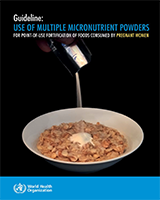Micronutrients are only needed in very small quantities but are essential for normal physiological function, growth and development. Deficiencies of micronutrients such as vitamin A, iron, iodine and folate are particularly common among during pregnancy, due to increased nutrient requirements of the mother and developing fetus. These deficiencies can negatively impact the health of the mother, her pregnancy, as well as the health of the newborn baby.
Point-of-use fortification with multiple micronutrient powders refers to the addition of powders containing vitamins and minerals to energy-containing foods at home or in any other place where meals are to be consumed, such as schools, nurseries and refugee camps.
This publication is a WHO guideline. A WHO guideline is any document, whatever its title, containing WHO recommendations about health interventions, whether they be clinical, public health or policy interventions. A recommendation provides information about what policy-makers, health-care providers or patients should do. It implies a choice between different interventions that have an impact on health and that have ramifications for the use of resources. All publications containing WHO recommendations are approved by the WHO Guidelines Review Committee.
Suggested citation:
WHO. Guideline: Use of multiple micronutrient powders for point-of-use fortification of foods consumed by pregnant women. Geneva: World Health Organization; 2016.
The designations employed and the presentation of the material in this publication do not imply the expression of any opinion whatsoever on the part of the World Health Organization concerning the legal status of any country, territory, city or area or of its authorities, or concerning the delimitation of its frontiers or boundaries. Dotted lines on maps represent approximate border lines for which there may not yet be full agreement.
The mention of specific companies or of certain manufacturers' products does not imply that they are endorsed or recommended by the World Health Organization in preference to others of a similar nature that are not mentioned. Errors and omissions excepted, the names of proprietary products are distinguished by initial capital letters.
All reasonable precautions have been taken by the World Health Organization to verify the information contained in this publication. However, the published material is being distributed without warranty of any kind, either expressed or implied. The responsibility for the interpretation and use of the material lies with the reader. In no event shall the World Health Organization be liable for damages arising from its use.

